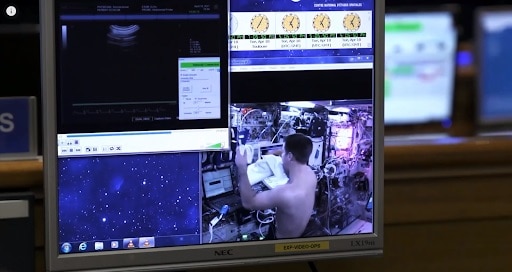
The French Society of Radiology (SFR) and the country’s national centre for space exploration (CNES) have signed a partnership, details of which were streamed live at the Journées Francophones de Radiologie (JFR) congress on 4 October. The aim is to develop imaging solutions to be sent on space flights and to collaborate on image collection and optimization, teleradiology and training of astronauts.
France has the largest space program in Europe and the third oldest institutional space programme in history, along with Russia and the US. CNES, which has a long track record in space exploration, recognizes the great potential of diagnostic imaging for monitoring astronauts’ health while on missions, according to general director Lionel Suchet.
The plan is to create a “two-way street” in which radiologists and space experts will collaborate on innovative projects to make further progress, JFR delegates heard online at the plenary Antoine Béclère lecture. A SFR–CNES working group will now define the research themes and establish a schedule of tasks ahead by December.
Shared interests
Discussing the deal, SFR president Jean-François Meder noted how the collaboration would shed light on the interest of space exploration for imaging and the role of medicine in space.
“We share the same interests: the support of innovation, and research. Today SFR and its members have needs, the first is to be able to discuss and collaborate with real professionals. Your [astronaut] teams have become true imaging professionals,” he said. “The second is the need to dream. This partnership between the SFR and the CNES will allow our radiologists to dream.”
Suchet pointed to the priority of getting crews back in good health after a mission, noting that the priority of the partnership is developing operational medicine on board the space station. The second aspect is to harness imaging in the longer term for research.

“Microgravity present in space stations makes them not only science laboratories but also tools for medical research to explore its effect on the human body,” he said.
CNES hopes that working with SFR will allow researchers to better explore health issues associated with this microgravity effect, such as cardiovascular problems, muscle loss, osteoporosis and a certain model of accelerated ageing.
For the SFR, the partnership will be a means to benefit from knowledge gained by astronauts. Discoveries from monitoring the process of accelerated ageing in astronauts, for example, could be applied to patients on Earth, helping radiologists understand the evolution of muscle mass loss, or osteoporosis, markers of patient fragility when they are exposed to cancer treatment, for example.
Beautiful adventure
In a special film broadcast during the JFR session, Claudie Haigneré (rheumatologist, astronaut and counsellor for the European Space Agency) explained how imaging can demonstrate the impact of microgravity – not only on the heart but also on other organs, such as the brain and the eyes. If such transformations can be imaged and followed, they can also be predicted.
Furthermore, after returning to Earth, astronauts undergo a complete reversal of the phenomenon, providing a platform for experimentation to better understand and treat associated symptoms. Such a model of the process of accelerated ageing and of the correction of these anomalies, would contribute to making predictive models of recuperation.
Imaging tools for future missions will be essential elements, but any progress will necessitate innovation and creativity and will also be very important for issues on Earth.
“Together we have to work and perfect the imaging tools that will accompany us. Space exploration is an international co-operative venture, whether this is with the SFR or European industrial bodies which will contribute new imaging methodology, Europe must make its voice heard … because it’s a beautiful adventure, the adventure of tomorrow,” Haigneré elaborated.
Interventional training
With the space station 400 km above the planet, communication from the ground with teleultrasound specialists in real-time is feasible. However for longer missions, communication may take from 20 to 40 minutes for information transferral. In this respect, crews will have to be even more autonomous than they are now for medical matters. Therefore the SFR has pledged as part of the partnership to contribute to astronaut training to improve diagnostics in real time. Such education will cover interpretation of radiological images, methods of image compression and training in interventional radiology.
“It seems to us that interventional radiology, and therapy, will become a major aspect, notably on long missions. Should therapy be needed, minimally invasive interventional radiology will be key,” noted JFR 2020 president Alain Luciani at the session.
Generally, astronauts are selected for their underlying good health. Only one case of venal thrombosis has ever been diagnosed via ultrasound and was treated on the space station, according to Suchet. Nevertheless diagnosis is paramount should the need arise.

At present, astronauts use ultrasound for different organs including the heart and brain, and eye tomography for potential ocular problems related to microgravity. Imaging in space would need to move beyond just ultrasound, noted Luciani. Interventional radiology will need to be made compatible with a long-distance mission and safe for the astronauts and would need to be as small as possible. Telemedicine will be another convergent theme between the SFR and CNES.
Ahead to the future
In a later stage of the partnership, techniques for noise reduction from the research team at CNES could be applied to radiology, the presenters noted.
There will also be a chance for collaboration on image analysis using artificial intelligence (AI). CNES uses AI analysis of satellite images of the Earth to understand phenomena linked to climate change. Techniques based on AI algorithms and data processing to mine the useful data from the mass of information and are very similar to those needed for advanced medical image analysis, according to Suchet, pointing to this other fruitful area of collaboration, where the partners could enrich and help each other.
- This article was originally published on AuntMinnieEurope.com ©2020 by AuntMinnieEurope.com. Any copying, republication or redistribution of AuntMinnieEurope.com content is expressly prohibited without the prior written consent of AuntMinnieEurope.com.
